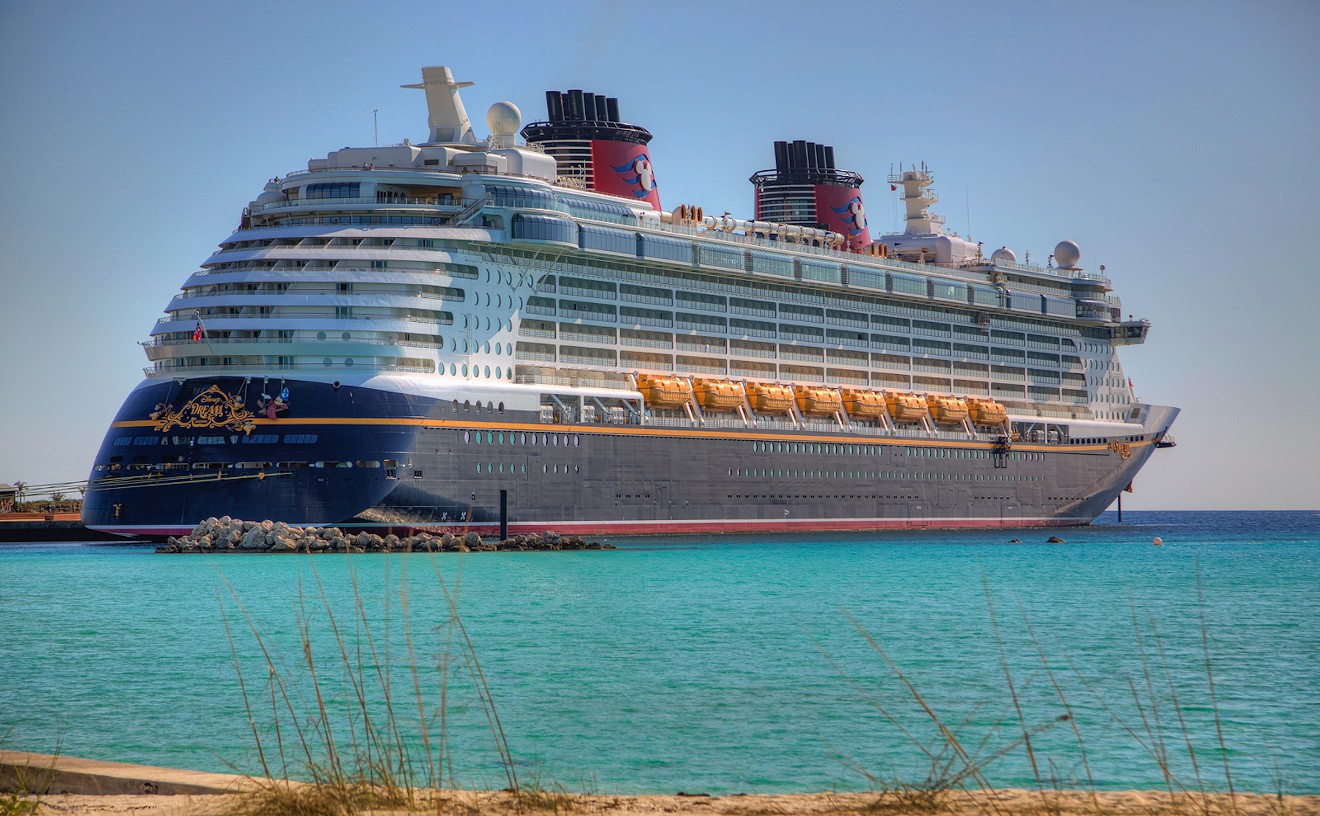Frail figures were bathed in flashes of red and blue police lights as wrinkled arms swung cardboard signs. Around twilight last Wednesday, dozens of Cuban-Americans, most of them elderly and angry, took turns screaming Spanish epithets into fuzzy-sounding bullhorns.
"Che is a liar!" Jose Mizrahi, age 79, bellowed as he rattled a metal barricade across 71st Street from the Byron Carlyle Theater in Miami Beach. "He is a killer!"
Raul Garcia, a tall, thin 68-year-old from Hialeah, took a step back from the curb and shook his head sadly. "I love democracy," he said. "But I do not respect this, showing a film like this in Miami."
A younger man walked by in an olive T-shirt adorned with one of the world's most famous images: a bearded revolutionary in a beret, staring intently into the distance. Except on this shirt, Che's face was crossed out in red and marked with: "Cold Blooded Killer."
Inside the small, plush movie theater, the architect of the evening's madness smirked. Director Steven Soderbergh, a thin 45-year-old with a close-shaved head and thick-rimmed glasses, stood on a small stage in front of a white screen, just to the right of star Benicio Del Toro (who managed a mumbled "Thanks for coming," as if in character as Fred Fenster from The Usual Suspects). Soderbergh smiled at the crowd of about a hundred film buffs.
Just before his new epic about Cuban revolutionary Che Guevara cued up, Soderbergh pronounced, nodding toward the street, "Obviously not everyone is glad we're here. But I'm glad we're all here tonight."
The next morning, New Times visits Soderbergh in his suite on the 17th floor of the Mandarin Oriental to find out how the Oscar-winning director caught Che fever, why he came up with a four-hour monster of a film, and why he decided to stage a premiere in the heart of Cuban nationalism.
Soderbergh reclines in a plastic chair, framed by a panoramic view of sailboats floating by Brickell Key, and adjusts his glasses.
New Times: Were you expecting that kind of protest last night?
Soderbergh: We knew there'd be a lot of unhappy people here. But you can't not show a movie about Che here. You kind of have to come to Miami. It was a no-win situation, I guess, but the worst version was not coming here and not facing the protests.
NT: Why Che? How did this project start?
Soderbergh: It all started when we were filming Traffic [the 2000 Oscar-winning feature about the Mexican-U.S. drug trade]. We were working on [the movie], and Laura Bickford, the producer, and Benicio had gotten involved with the project and started asking, 'Is this something you want to be a part of?' And at the time, it seemed like a good idea. It was complicated but interesting because he's sort of born to be in a movie in a way. It's funny, because when we got involved, I thought, 'He's such an interesting guy, why there aren't more movies about him?' Four years in, I realized ... why there aren't. Because it's hard to know what to show about his life.
NT: You ended up with a four-hour movie split into two parts. Why?
Soderbergh: When the project started, it was just going to be about Bolivia. When I think about it now, that was because it was the part of his life that I knew the least about and that I thought people knew the least about. Then we got into working on that and I felt suddenly, well, we need more context. If it's just Bolivia, you're going to be thinking the whole time, 'Why doesn't he leave?' Then I started thinking OK we're back in Cuba, because then you understand why he thinks [the revolution] is going to work. Then I found out he went to New York, and ... then I thought, well you've got to have him meeting Fidel in Mexico City. So this thing just started ballooning out. And I think I took a cue from nature in a way. When a cell gets too large, it divides to survive.
NT: The two narratives, about the success in Cuba and the failure in Bolivia, provide an interesting contrast.
Soderbergh: He didn't see what was different about the two campaigns, what was missing from the Bolivian campaigns. It's kind an example of a belief blinding you from the reality of what's going on. You see examples of this all over the world every day. The most glaring example being, in Bolivia, he didn't have a Fidel, an indigenous, well-known political flash point to pin the revolution on. Remember, when he was on that boat heading for Cuba, Fidel was already famous. He was a rock star in Cuba. He'd raided the barracks, he'd been in jail for two years, and then exiled. He was famous. Part of me has to believe that Che thought when he got to Bolivia and people heard it was Che, people were going to stand up and rally behind him the same way. I don't know how else he thought this was going to work.
NT: Why are Americans still so fascinated with this guy? Why do you see so many kids wearing his face on their T-shirts?
Soderbergh: I think it's because, whatever they think about him politically, he's not a sell-out. This is a guy who walked the walk. Whenever I get into these arguments with people about Che, they talk about La Cabaña (when Che led post-revolution executions of hundreds of Batista supporters). I say, 'Well yeah, he did that stuff.' And he died the way he died because he's the real deal. He went back into the jungle, walked away from his family, and tried to do it again and was executed without a trial in a room as big as this one. So you may hate him, but you can't deny this guy was consistent and knew that an armed revolution means killing people and means you can be killed. And he was fine with that. He was down with that.
But that question is a big part of the reason I got involved. I didn't know much more than the T-shirt, frankly, when Benicio and Laura came to me. I've seen the image and I know it has meaning for people. But why? What did he do that should generate this much merchandising? That's the really crazy part, that this icon of Marxism and armed revolution is like one of the most successful commercial brands on the planet. He'd think it was insane.
Insane is a word many people threw around at the anti-Che protest outside the Byron Carlyle.
"It's an insult to our community that a film like this would premiere here," said Abilio Leon, a 65-year-old from Hialeah. "The Jewish community would never allow any kind of film about Hitler like this to play here. It's the same for us."
He looked at the throngs of protesters and the well-dressed crowd milling inside the theater and waved his sign a little harder.
"We'd rather just forget about the guy."
Coming Soon
Che, a four-hour epic about revolutionary Che Guevara, is split into two-hour halves. The first, The Argentine, follows Che's role in the Cuban Revolution. The second, Guerrilla, covers his failed attempt to lead a similar coup in Bolivia. The film is scheduled to open this week in New York and Los Angeles, and should reach Miami theaters in January.
"You may hate him, but you can't deny this guy knew that an armed revoluion means killing people and means you can be killed."











